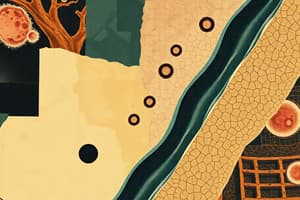Podcast
Questions and Answers
What is the primary role of the extracellular matrix (ECM) in both plants and animals?
What is the primary role of the extracellular matrix (ECM) in both plants and animals?
- Nutrient absorption
- Photosynthesis
- Structural support and shape (correct)
- Energy storage
The primary cell wall is formed after the secondary cell wall in plants.
The primary cell wall is formed after the secondary cell wall in plants.
False (B)
What are the two primary components of the plant cell wall?
What are the two primary components of the plant cell wall?
Cellulose and pectin
The two types of plant cell walls are the primary wall and the ______.
The two types of plant cell walls are the primary wall and the ______.
Match the following components of the plant cell wall with their functions:
Match the following components of the plant cell wall with their functions:
Which of the following is NOT a component of the extracellular matrix in animals?
Which of the following is NOT a component of the extracellular matrix in animals?
The extracellular matrix in animals is inert and does not play a role in cellular activities.
The extracellular matrix in animals is inert and does not play a role in cellular activities.
Name one protein found in the extracellular matrix in animals.
Name one protein found in the extracellular matrix in animals.
What is the primary role of anchoring junctions?
What is the primary role of anchoring junctions?
Tight junctions are present in both vertebrates and invertebrates.
Tight junctions are present in both vertebrates and invertebrates.
What are the transmembrane proteins that form the basis of tight junctions?
What are the transmembrane proteins that form the basis of tight junctions?
Gap junctions consist of transmembrane proteins called ________, which allow communication between adjacent cells.
Gap junctions consist of transmembrane proteins called ________, which allow communication between adjacent cells.
Match the following junctions with their primary function:
Match the following junctions with their primary function:
Which type of junction is primarily involved in signal relaying between adjacent cells?
Which type of junction is primarily involved in signal relaying between adjacent cells?
Integrins are solely involved in cell adhesion to other cells.
Integrins are solely involved in cell adhesion to other cells.
What is the main function of desmosomes in a multicellular organism?
What is the main function of desmosomes in a multicellular organism?
______ junctions are characterized by tightly packed cells preventing the diffusion of substances, found mainly in vertebrates.
______ junctions are characterized by tightly packed cells preventing the diffusion of substances, found mainly in vertebrates.
Which junction is exclusive to plant cells?
Which junction is exclusive to plant cells?
Flashcards
Basement Membrane (in Kidney)
Basement Membrane (in Kidney)
A specialized layer found in the kidneys, acting as a barrier between capillaries and the tubule walls, preventing the passage of proteins.
Extracellular Matrix (ECM)
Extracellular Matrix (ECM)
A complex network of molecules outside the cell membrane, providing structural support, regulating cell behavior, and acting as a communication hub.
Plant Cell Wall
Plant Cell Wall
A rigid, protective structure surrounding plant cells, composed of cellulose, hemicellulose, pectin, and proteins. It provides structural support, regulates cell growth, and acts as a barrier.
Cellulose
Cellulose
Signup and view all the flashcards
Hemicellulose
Hemicellulose
Signup and view all the flashcards
Pectin
Pectin
Signup and view all the flashcards
Extensins (Plant Cell Wall)
Extensins (Plant Cell Wall)
Signup and view all the flashcards
Animal Extracellular Matrix
Animal Extracellular Matrix
Signup and view all the flashcards
What are cell junctions?
What are cell junctions?
Signup and view all the flashcards
What are anchoring junctions?
What are anchoring junctions?
Signup and view all the flashcards
What are adherens junctions?
What are adherens junctions?
Signup and view all the flashcards
What are desmosomes?
What are desmosomes?
Signup and view all the flashcards
What is integrin?
What is integrin?
Signup and view all the flashcards
What are tight junctions?
What are tight junctions?
Signup and view all the flashcards
What are gap junctions?
What are gap junctions?
Signup and view all the flashcards
What are plasmodesmata?
What are plasmodesmata?
Signup and view all the flashcards
What is the extracellular matrix (ECM)?
What is the extracellular matrix (ECM)?
Signup and view all the flashcards
What is the basal lamina?
What is the basal lamina?
Signup and view all the flashcards
Study Notes
Cell-Cell Interactions
- Cells in multicellular organisms interact via cytoskeletal filaments
- Mechanical stresses are transmitted through cytoskeletal filaments, attached to cell-matrix and cell-cell adhesion sites
- Extracellular matrix directly experiences mechanical stresses, like tension and compression.
Cell Junction Classification
- Anchoring junctions: connect cells via actin filaments (adherens junctions, focal contacts). They also connect cells to the extracellular matrix via intermediate filaments (desmosomes, hemidesmosomes).
- Occluding junctions: tight junctions are found only in vertebrates, septate junctions in invertebrates.
- Channel-forming junctions: gap junctions facilitate communication and transport of small molecules between cells. Plasmodesmata exist in plant cells.
- Signal relaying junctions: these facilitate cell signaling, including synapses in the nervous system, interactions in the immune system, and cell-cell interactions involving delta-Notch.
Cellular Adhesion
- Adhesion is crucial for proper structure and function of multicellular organisms, involving a variety of cellular adhesions.
- Mechanisms include:
- Tight junctions seal gaps between epithelial cells, enabling selective permeability differences.
- Adherens junctions and desmosomes connect actin and intermediate filaments to create a robust cell-cell anchoring system.
- Gap junctions allow small molecules to pass between cells, enabling electrical and chemical signaling.
- Hemidesmosomes anchor intermediate filaments for cell attachment to the extracellular matrix.
Cell Junctions: Proteins
- Anchoring junctions involve transmembrane adhesion proteins, extracellular ligands, and intracellular cytoskeletal attachments.
- Specific anchoring junction types, such as adherens junctions, desmosomes, and hemidesmosomes, use designated proteins (e.g., cadherins, desmoglein, desmocollin, and integrins).
- Other types of junctions also have specialized protein components, like those involved in tight junctions, gap junctions, and signal relaying junctions.
Additional Cell Junctions
- Integrins: Proteins involved in cell adhesion, particularly cell-matrix adhesion. They play roles in cell signaling and are involved in interactions between cells and their surrounding extracellular matrix.
- Selectins: Cell adhesion molecules primarily involved in cell interaction, primarily within blood vessel pathways. They are important in cell-cell interactions within circulatory systems.
- Integrins, selectins and other proteins are crucial for cell-cell interactions and communication within tissues. These molecules are involved in establishing and maintaining cell polarity, tissue structure, and communication.
Basal Membranes
- Surrounds muscle and fat cells
- Located beneath epithelial cells and is a critical site for cell attachment
- Plays a role in cellular migration
- Functionally acts as a barrier in places such as kidney glomeruli blocking large proteins moving into and out of the glomerular capillaries.
Extracellular Matrix
- Cells release protein components into the extracellular matrix that create a strong structural mesh between cells.
- The matrix creates structure between cells and provides a supportive framework for tissues.
- ECM components play important functional roles both structure and cell signaling.
Cell Wall Structure
- Plant cell walls are composed of primarily cellulose, which creates structural support.
- These polymers are strengthened and interconnected by hemicellulose and pectin polymers for additional reinforcement.
- Proteins, especially extensins, contribute to cell wall physical properties and provide a barrier against pathogens.
ECM Diseases
- Mutations in collagen components can lead to conditions like osteogenesis imperfecta, characterized by brittle bones and fragile tissues.
- Conditions that affect collagen production and/or function commonly exhibit connective tissue abnormalities.
- Genetic disorders and environmental factors can affect ECM structure and lead to abnormalities in tissues which impact their functionality.
Studying That Suits You
Use AI to generate personalized quizzes and flashcards to suit your learning preferences.





